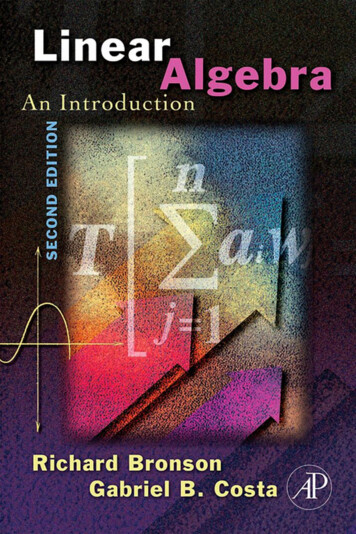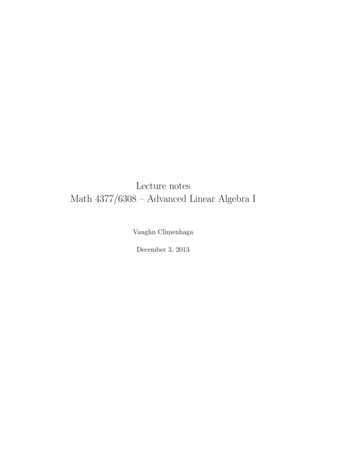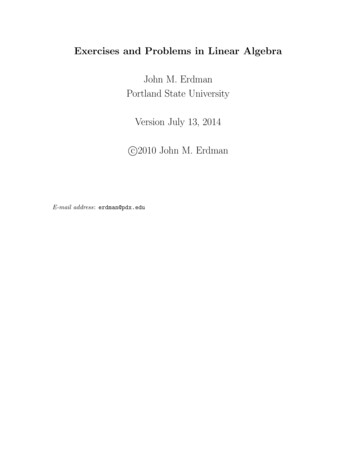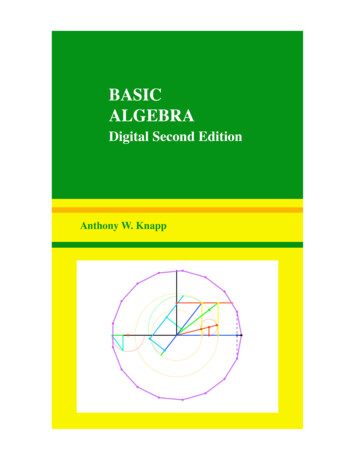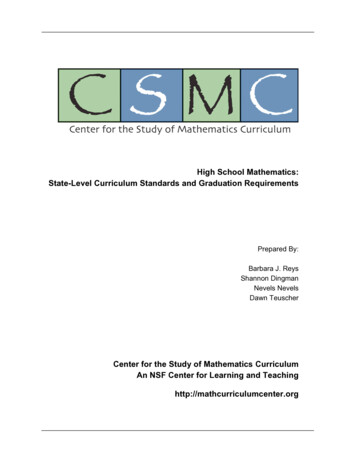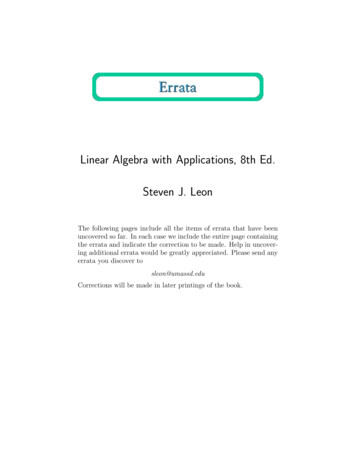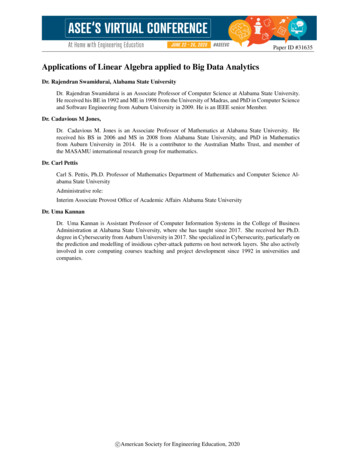
Transcription
Paper ID #31635Applications of Linear Algebra applied to Big Data AnalyticsDr. Rajendran Swamidurai, Alabama State UniversityDr. Rajendran Swamidurai is an Associate Professor of Computer Science at Alabama State University.He received his BE in 1992 and ME in 1998 from the University of Madras, and PhD in Computer Scienceand Software Engineering from Auburn University in 2009. He is an IEEE senior Member.Dr. Cadavious M Jones,Dr. Cadavious M. Jones is an Associate Professor of Mathematics at Alabama State University. Hereceived his BS in 2006 and MS in 2008 from Alabama State University, and PhD in Mathematicsfrom Auburn University in 2014. He is a contributor to the Australian Maths Trust, and member ofthe MASAMU international research group for mathematics.Dr. Carl PettisCarl S. Pettis, Ph.D. Professor of Mathematics Department of Mathematics and Computer Science Alabama State UniversityAdministrative role:Interim Associate Provost Office of Academic Affairs Alabama State UniversityDr. Uma KannanDr. Uma Kannan is Assistant Professor of Computer Information Systems in the College of BusinessAdministration at Alabama State University, where she has taught since 2017. She received her Ph.D.degree in Cybersecurity from Auburn University in 2017. She specialized in Cybersecurity, particularly onthe prediction and modelling of insidious cyber-attack patterns on host network layers. She also activelyinvolved in core computing courses teaching and project development since 1992 in universities andcompanies.c American Society for Engineering Education, 2020
Applications of Linear Algebra applied to Big Data Analytics1. IntroductionThe digital universe (the data we create and copy annually) is doubling every two years and willreach 44 zettabytes (44 trillion gigabytes) in 2020 [1]. The stored digital data volume has grownexponentially over the past few years [2, 3]. In 1986, only three exabytes of data existed and in2011 it went up to 300 exabytes [3], and at the end of 2020 it might reach 44,000 exabytes [1].Moreover, the International Data Corporation (IDC) forecasts that in 2025 we will be producing165 zettabytes of data per year [4]. There is an increasing demand for doing everything onlinewhether it is in our work or private life and this increase is responsible for this explosion of databeing created. In conjunction, we also employ smart devices that are continuously connected tothe internet and produce constant streams of real-time data about things that range from ourheartrate to our current location. It is estimated that today (in 2019) more than four billion peopleare online and in 2020 every person will produce 1.7 megabytes of data every second [4], andmillions of enterprises are becoming more and more web based. In addition, there are millions ofsensors and communicating devices transmitting data over the internet adding to the digitaluniverse [1]. It is expected that in 2020, over 10 billion mobile devices will be in use [5] and thiswill make the digital universe ever larger. This exponential data growth is observed almost in allsectors, including government, healthcare, banking, manufacturing, retail, transportation, andeducation [6]. For example, in 2019, there were 2.3 billion active Facebook users [4] and morethan 30 petabytes of data handled by Facebook [5]. Twitter users send over 230 million tweetsevery day [5] at an average half-a-million tweets per minute [4]. There are over 1 billion Googlesearches every day [5], Walmart records around 267 million transactions (4 petabytes) per day[7], Netflix streams over 1 billion hours of TV shows and movies per month [1], and YouTubeusers upload 5 hours of video per second [8]. In addition to this, the modern telescopes are datadriven and they produce enormous amounts of data, for example, the Australian SquareKilometer Array Pathfinder (ASKAP) radio telescope streams data at a rate of 2.8 Gigabytes persecond [1], and the proposed Large Synoptic Survey Telescope (LSST) will record 15 Terabytesof data every night [9]. Similarly, the Large Hadron Collider (LHC), a particle accelerator [10],helps us to understand the workings of the Universe and will generate 60 terabytes of data perday [7].The sudden increase in the digital universe (Big Data) opened doors for new types of dataanalytics called big data analytics and new job opportunities [11]. In 2012, only 23% oforganizations had an enterprise-wide Big Data strategy [5, 12], whereas today 97.2% oforganizations are investing in Big Data [4]. A recent Harvard Business Review [13] survey ofsenior Fortune 500 and federal agency business and technology leaders report that 70% of therespondents plan to hire data scientists. The U.S. Bureau of Labor Statistics (BLS), OccupationalOutlook Handbook 2018 [11] projects that there will be a 34% increase in data analytics jobsfrom 2016 to 2026. A McKinsey Global Institute research report [14] indicates that the demandfor big data analytical talent could be very high and will produce 50 to 60 percent more dataanalytic jobs. Similarly, a Forbes report indicates that there will be 2.7 million data science andanalytic job openings by 2020 [4].1
A recent survey from Harvard Business Review [13] indicates that 85% of the organizations thatthey surveyed revealed that they planned to fill 91% of their data science jobs with newgraduates. Though the private sector asks at least a master’s degree in mathematics or statisticsfor data analytics jobs, the government sector requires only a bachelor’s degree [15]. Moreover,it is impractical to fill this huge demand for big data analytics through only from graduate degreeholders in mathematics-related fields. The Harvard Business Review [13] report also indicatesthat 70% of the organizations that they surveyed report that finding big data talent as challengingor impossible. The hiring scale for big data jobs is 73%; this high score indicates the amount ofdifficulty in finding skillful candidates for the job [16]. In order to address this serious problem,Alabama State University with the support of Auburn University employed a unique techniquecalled infusing big data analytics in various undergraduate mathematics and statistics courses.Our big data course modules walked students through producing working solutions by havingthem perform a series of hands-on big data exercises developed specifically to apply cuttingedge industry techniques with each mathematics and statistics course module. We stronglybelieve that equipping students with such skills greatly improves their employability. Linearalgebra concepts such as feature extraction, clustering, and classification involving themanipulation of large matrices are extensively used in big data analytics; therefore, this is anatural course to start introducing students to big data analytics. This paper presents our fouryears’ experience in adapting and integrating big data concepts into undergraduate linear algebracourses.2. Linear Algebra and Big DataLinear algebra topics such as linear equations, eigenvalue problems, principal componentanalysis, singular value decomposition, quadratic forms, linear inequalities, linear programming,optimization, linear differential equations, modeling and prediction, and data mining algorithms(frequent pattern analysis, classification, clustering, and outlier detection) are frequently used inpractice by Big Data Analytical applications. [17] Particularly, matrix algorithms constitute thecore of modern Big Data Analysis. Because, matrices provide a convenient mathematicalstructure for modeling a wide range of applications’ data. For example, information about ‘N’objects with ‘D’ features can be easily described/encoded by an ‘NxD’ matrix. [18]Manipulations of large matrices are used in feature extraction, clustering, and classification.Matrix decomposition is used in principal component analysis for dimension reduction.Similarly, application of eigenvectors used in Google’s PageRank method. [19]The versatility of graphs can be seen from their ability to illustrate important aspects of moderncomputer science, the intricacies geography, linguistic complexities, and the consistency ofchemical structures. Incorporating linear algebra allows for representation of these graphs asmatrices, this completes the pertinent task of enhancing their computational aspects. [20] Linkeddata is usually represented by a graph in Big Data applications [19]. We define a graph G as anordered pair (V (G),E(G)) consisting of a set V (G) of vertices and a set E(G), disjoint from V(G), of edges, together with an incidence function ψG that associates with each edge of G anunordered pair of (not necessarily distinct) vertices of G. Using this definition the vertices of agraph can represent webpages, genes, image pixel, or interacting users, and edges representrelations or links between the vertices [21]. Notions such as centrality, shortest path, andreachability can be derived from the graph using graph analytics. A widely used practicalapplication of large graph analytics is the internet search engine. [19] Some widely used methods2
in Big Data Analytics that incorporate the utilization of graphs is to visualize big data as graphs(e.g. the World Wide Web), computation for strongly connected large graphs (e.g. PageRank forstrongly connected graphs), and finding matchings in bipartite graphs (e.g. internet advertising)are [19]. Many practical applications of large graph analytics exist, including internet searchengines. One obstacle that presents itself with graphs is the humongous sizes that are involvedwith the numerous millions of vertices that could exist. Low rank approximation of the adjacentmatrices or graph Laplacians in relation to the graphs compared in the analysis of andinterpretation of the data. [21]Practical Big Data applications that use linear algebra include, but are not limited to: 1) Google’sPage Rank Algorithm, 2) Recommender Systems (e.g., Netflix, Pandora, Spotify), 3) TopicModeling (e.g., Wikipedia, Genome Sequence Analysis), 4) Social Network Analysis (e.g.,Facebook, MySpace, LiveJournal, YouTube), 5) Internet Search, 6) Complex System Analysis(e.g., Biological Networks), 7) Image Segmentation, 8) Graph Clustering, 9) Link Prediction,and 10) Cellular Networks. In Big Data Analytics, linear equations along with matrices arewidely used in large network analysis, Leontief economic models, a model for the economics ofa whole country/region in which consumption equals production [22], and ranking of sportsteams [23]. [17] Eigenvalues and eigenvectors are used in Google’s PageRank algorithm,networks clustering, and weather system modeling [17] and spectral decomposition, a matrixapproximation technique which uses eigenvectors, are used in spectral clustering [24], linkprediction in social networks [25], recommender systems with side-information [26], densest ksubgraph problem [27], and graph matchings [28]. [29] Principal component analysis andSingular Value Decomposition techniques are used to compare the structure of folded proteinsand in Dimension Reduction techniques such as image compression, face recognition, and ElNino [17]. Optimization, a minimization of a quadratic expression, and linear programming arewidely used in the stable marriage problem, production planning, portfolio selection [23],transportation problem, minimization of production costs, minimization of environmentaldamage, and maximization of profits. [17] Practical applications like face recognition, fingerprintrecognition, plagiarism finding, and Netflix movie ratings are using similar items and frequentpatterns concepts [17, 30].3. Infusing Big Data Analytics in UG Linear Algebra CourseTo facilitate the Big Data infusion and active learning in the linear algebra course, we employeda two-part module. The first part focused on theoretical and conceptual ideas behind the methodsunder discussion and the second part had hands-on experimentation using real-world data. Thestudents are advised to use both R and Python general-purpose programming languages tocomplete their projects. The students can also use MATLAB programming to perform theirproject as well as MS Excel.The initial set of topics in which we integrated big data analysis methods were chosen using twocriteria: suitability of material for pedagogical integration of big data methods and impact on allcomputing and Mathematics majors. Instructors may eventually choose to expand the integrationof Big Data concepts to other computing and Mathematics courses in the future. The followingbig data lectures and lab modules were infused to the existing linear algebra course:3
Lecture: To begin, the students were provided with a pretest to gauge their understanding of BigData Analytics and how linear algebra can be applied. This data was later paired with a posttestthat was given as the last component of the module. The instructor presented the class with aconcept of “Big Data” that best suits the linear algebraic viewpoint. In linear algebraic terms wedefine big data as data that can be represented as an m n array with large m and large n. Thegoal of the lecture was to reinforce topics already outlined in the course syllabus while onlypresenting additional information, if it was absolutely necessary for students to understandaspects of the modules. Some of the topics already incorporated into the course curriculuminclude linear equations and matrices, eigenvalues, eigenvectors, and singular valuedecomposition. The lecture focused on methods for gathering data and representing such data inthe form of matrices and the utilization of basic applications of linear algebra on said matrices.The primary source for such data was www.data.gov and similar sites. In addition, students werepresented with the PageRank algorithm and a scenario utilizing it. Lastly, the lecture introducedthe topic of the Leslie Matrix and population change. Examples were kept as simple as possiblefor students to understand the complexities of certain algorithms or unfamiliar methods.Hands-on activities: Students were asked to:1) Classify data sets into categories that describe the shape of the data distribution. For this labactivity students were encouraged to use the practical big data techniques explained during thelecture when considering linear equations relating to business problems, tax problems, economicplanning models, problems for the input-output matrix for an economy producing transportation,and interpret data analytic problems. The data sets for this portion of the activity wereprearranged in order to allow for certain controlled outcomes and provide key discussion points.2) Investigate real data using eigenvalues, and eigenvectors to decipher information from thedata set. For this lab, students were encouraged to solve practical problems such as economicdevelopment problems, analysis of situations as diverse as land problems, applications instructural engineering, control theory problem, vibration analysis problem, electric circuitsproblem, and advanced dynamic problem and so on. Of the previous topics stated, instructorswere given the freedom to select from this group areas to focus on as part of the second portionof the activity. However, data was once again provided from sources such as www.data.gov.MATLAB was used as the primary computing tool when calculations would exceed those gainedfrom simple introductory examples. Given that all students were not previously familiar withMATLAB, step-by-step “cheat sheets” were used when working through examples and as areference for using MATLAB.Students were then provided with an out-of-class assignment to further their research, as well asreinforce their understanding of how linear algebra could be applied to Big Data Analytics.Assignment: The assignment focused on a complexity analysis of the PageRank Algorithm andwas titled “The Mathematics of Google Search.” Given that this was an undergraduate coursemodels were constructed from real world data, but altered as not to produce an unnecessarynumber of iterations that would distract from the purpose of the assignment.Upon their return to class students were asked to engage in a classroom discussion based onquestions contained in their assignment called “Questions for Class Discussion.” These questions4
were meant to understand, from the students’ point of view, the value of the module and theirfeelings toward applying class material in such a manner.In order to understand as completely as possible the student's competency, certain standards wereconsidered. There were several standards addressed to some degree by this project. Thestandards are: Students will be able to: collect data, display data in a graphical manner, interpretdata as a matrix, apply techniques already contained within the curriculum; develop models;determine levels of accuracy needed; organize materials; interpret the data and draw a conclusionfrom the data; explain their thought process.The criteria which identified indicators of good performance on the task and in class discussionswere: accuracy of calculations accuracy of models and graphs usage of algorithms organization of calculations clear explanationsAs mentioned, the culmination of the module came in the form of a posttest designed to, amongother things, show if the students had a better understanding of the topic than when they began.4. ResultsDuring spring 2016, fall 2016, and spring 2017 semesters, Alabama State University facultydeveloped Big Data modules to infuse into the existing Introduction to Linear Algebra andDiscrete Mathematics courses. After the beta test between spring 2016 to spring 2017, these BigData modules went through various updates – some based on student feedback and some due tothe change in computer hardware and software from fall 2017 to fall 2019. These modules wereevaluated for their effectiveness through pre- and post-tests. In addition, students in all offeredclasses were asked to complete a survey pertaining to their coursework, confidence in using bigdata modules in their classes, and strategies they use to learn in their math classes.4.1. Student KnowledgeStudents in each class completed pre- and post-tests to examine changes over the duration of themodule implementation. In each class, there were students that failed to complete the pre, post,or both tests. Overall, scores on the pre-tests averaged just 36.63% while averaging 80.69% onthe post-tests. The box plot and paired t-test results are shown in figure 1 and figure 2respectively. The two-tailed P value for the 95% confidence interval less than 0.0001, byconventional criteria, this difference is extremely statistically significant.5
Figure-1: Box Plot (Student Knowledge)P value and statistical significance:The two-tailed P value is less than 0.0001By conventional criteria, this difference is considered to be extremely statistically significant.Confidence interval:The mean of PreTest minus PostTest equals -44.058895% confidence interval of this difference: From -52.2025 to -35.9152Intermediate values used in calculations:t 10.8667df 50standard error of difference 4.054Review of the data:Group PreTest PostTestMean 36.6275 80.6863SD23.3169 15.8600SEM 3.2650N512.220851Figure-2: Paired t test results4.2. Matched Pre-Post Student KnowledgeTo better examine gains made by students after using these modules, the analysis was limited tothose students with complete pre- and post-test data. A total of 44 students had completed boththe pre- and post-test. Scores for this matched sample increased from pre-test (M 35.14,SD 23.5) to post-test (M 83.61, SD 14.75). Using a paired-samples t-test, changes from pretest to post-test were statistically significant (t 14.09, p 0.0001). These results are summarizedin figure-3 (boxplot) and figure-4 (paired t-test).6
Figure-3: Box Plot (Matched Student Knowledge)P value and statistical significance:The two-tailed P value is less than 0.0001By conventional criteria, this difference is considered to be extremely statistically significant.Confidence interval:The mean of PreTest minus PostTest equals -48.477395% confidence interval of this difference: From -55.4153 to -41.5393Intermediate values used in calculations:t 14.0910df 43standard error of difference 3.440Review of the data:Group PreTest PostTestMean 35.1364 83.6136SD23.4963 14.7463SEM 3.5422N442.223144Figure-4: Paired t test results4.3. Confidence in using Big Data Modules in ClassIn spring 2016, nearly 80% of the overall survey respondents were either juniors or seniors andnearly 30% were enrolled as computer science majors. The sample was balanced in terms ofgender (52.9% female), but offered little diversity in terms of race, ethnicity or disability. In Fall2016, nearly 95% of the overall survey respondents were either juniors or seniors and over 38%were enrolled as computer science majors. The sample offered little diversity in terms of race,ethnicity or disability and over 32% were female. In spring 2017, nearly 95% of the overallsurvey respondents were either juniors or seniors and nearly 28% were enrolled as computerscience majors. The sample had a larger number of males (53.1%), with majority of participantsidentifying as Black (87.5%) and primarily not identifying with Hispanic or Latino ethnicity7
(90.6%). Using a 5-point scale (1 little of no confidence 5 A great deal of confidence),students were asked to respond to 31 different potential big data modules/applications. Theseresponses were requested prior to the implementation of modules in math coursework. In spring2016, only 8 out of 26 modules (30.8%) received an average response of 3 or above, in fall 2016,only 2 out of 26 modules (6.5%) received an average response of 3 or above, and in fall 2017, 30out of 31 modules (96.8%) received an average response of 3 or above.4.4. Student Academic Efficacy, Motivation and Learning Strategies in Math CoursesFinally, students were asked to respond to survey items pertaining to their level of academicefficacy, motivation and goals in learning math, and strategies that they use and prefer to learnmath.Academic Efficacy: Students were asked to respond to five items related to their academicefficacy as it pertains to the math class in which they were enrolled. Overall, students reported agreat deal of confidence in their academic abilities with the average for each term above 4 (on a5-point scale). Students believed that they would learn if they tried, worked hard, and did notgive up. They also believed that they could master the skills and figure out the most difficultclass work.Goals in Math: While all goals were important to them, students believed that getting a goodgrade was most important. They also wanted to meet requirements for their degree, improve theirability to communicate math ideas to others, learn new ways of thinking and specific proceduresfor solving math problems.Preferred Learning Environments: When asked to indicate their perceptions of statementsdescribing different learning environments, students reported the greatest agreement with “theinstructor explains the solutions to problems” and “the assignments are similar to the examplesconsidered in class.” Students also indicated situations in which they compared their mathknowledge to other students, studied their notes, explained ideas to others, worked in smallgroups, and got frequent feedback on their mathematical thinking. They were less supportive ofhaving the class critique their solutions, exams that prove their skills and group presentations.General Learning Strategies used by Students: In general, students reported using a variety ofstrategies in their math classes and not giving up when they get stuck. They most frequentlyreported finding their own ways of thinking and understanding and reviewing their work formistakes or misconceptions. They also reported checking their understanding of what a problemis asking, studying on their own and using their intuition about what an answer should be.Motivation to learn Math - Task Value: Students reported high levels of task value, indicatingtheir belief in the importance and utility of course content in their math classes. Theirunderstanding of math is extremely important to them and their motivation to learn math isstrong.Learning Strategy – Critical Thinking: In terms of learning math, students reported manystrategies that require critical thinking. They reported developing their own ideas based on8
course content and evaluating the evidence before accepting a theory or conclusion. They alsoreported questioning what they read or heard in class and thinking of possible alternatives.Learning Strategy – Self- Regulation: Students reported using many effective self-regulationstrategies in their math classes. In particular, they pay careful attention to concepts that they findconfusing and focus on studying and reviewing these, so they learn them.Learning Strategy – Time and Study Environment Management: Another positive strategyreported by students related to the management of their time and study environment. Theyreported attending class regularly, finding a place to study and keeping up with the weeklyreadings and assignments.The reliability of these scales was generally supportive, with internal consistency estimatesranging from 0.491 to 0.926, with a median of 0.867. Perceptions were also very positive asoverall scale means exceeded the scale midpoints.5. AcknowledgementsThis material is based upon work supported by the National Science Foundation under GrantNo.1436871.6. ConclusionsWe have created many one-week linear algebra big data modules and infused them into existingcore undergraduate mathematics courses over a period of four years. The modules were taughtusing examples that were worked through interactively during class. The students then workedon assignments that incorporated the new big data instructional concepts. We have evaluated thebig data modules effectiveness through pre- and post-tests, and surveys. The paired-samples ttest results show that matched pre-post student knowledge is statistically significant. Regardingconfidence in using big data modules in class, we had mixed results. Students’ perception wasvery positive as overall scale means exceeded the scale midpoints. We feel the courses were asuccess but indicated there was room for improvement.References1.2.3.4.5.The Digital Universe of Opportunities: Rich Data and the Increasing Value of the Internet of Things, EMCDigital Universe with Research & Analysis by IDC, April 2014, 4iview/executive-summary.htmSara Royster, “Working with big data,” Occupational Outlook Quarterly, 57, 3, 2-10, 2013Nicolaus Henke, Jacques Bughin, Michael Chui, James Manyika, Tamim Saleh, Bill Wiseman and GuruSethupathy, THE AGE OF ANALYTICS: COMPETING IN A DATA-DRIVEN WORLD, December2016, McKinsey & Company.Christo Petrov, "Big Data Statistics 2020," Tech Jury, March 2019, s/#grefQuick Facts and Stats on Big Data, IBM Big Data & Analytics Hub, Last Accessed 1/21/2020 -facts-and-stats-big-data9
24.25.26.27.28.29.30.Ralph Jacobson, "2.5 quintillion bytes of data created every day. How does CPG & Retail manage it?",IBM, April 24, 2013, d-every-day-how-does-cpg-retail-manage-it/Bryant R. E., Katz R. H., & Lazowska E. D. (2008). Big-Data Computing: Creating revolutionarybreakthroughs in commerce, science, and society: A white paper prepared for the Computing CommunityConsortium committee of the Computing Research Association. rnard Marr, "Big Data: 20 Mind-Boggling Facts Everyone Must Read", Forbes, September 30, stread/#322cdf0017b1Legacy Survey of Space and Time: Opening a Window of Discovery on the Dynamic Universe,https://www.lsst.org/The Large Hadron Collider, n-colliderBureau of Labor Statistics, U.S. Department of Labor, Occupational Outlook Handbook, Mathematiciansand Statisticians, on the Internet at atisticians.htm(visited January 30, 2018)The Digital Universe in 2020: Big Data, Bigger Digital Shadows, and Biggest Growth in the Far East,December 2012, 12iview/index.htmPaul Barth and Randy Bean, "There’s No Panacea for the Big Data Talent Gap", Harvard Business Review,November 29, 2012, -panJames Manyika, Michael Chui, Brad Brown, Jacques Bughin, Richard Dobbs, Charles Roxburgh, andAngela Hung Byers, "Big data: The next frontier for innovation, competition, and productivity", McKinseyGlobal Institute, May 2011https://www.sas.com/en us/insights/big-data/what-is-big-data.htmlLouis Columbus, "Where Big Data Jobs Will Be In 2016", Forbes, NOV 16, 15/11/16/where-big-data-jobs-will-be-in-2016Eli Tziperman, Applied Mathematics 120: Applied linear algebra and big data,https://canvas.harvard.edu/courses/4766 (Spring 2016), Last updated: May 19, 2016.Jiyan Yang, Randomized Linear Algebra for Large-Scale Data Applications, August 2016, StanfordUniversity, http://purl.stanford.edu/wr092fb7484Carl Pettis, Rajendran Swamidurai, Ash Abebe, and David Shannon, “Infusion of Big Data ConceptsAcross the Undergraduate Computer Science Mathematics and Statistics Curriculum,” 2018 ASEE AnnualConference & Exposition, June 24-27, 2018, Salt Lake City, UT, USADylan Johnson, GRAPH THEORY AND
3. Infusing Big Data Analytics in UG Linear Algebra Course To facilitate the Big Data infusion and active learning in the linear algebra course, we employed a two-part module. The first part focused on theoretical and conceptual ideas behind the methods under discussion and the second part had hands-on ex
